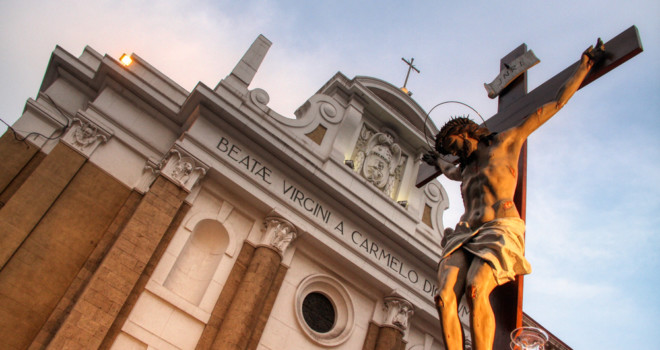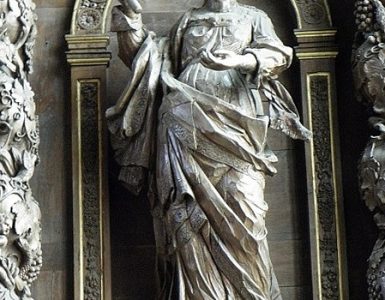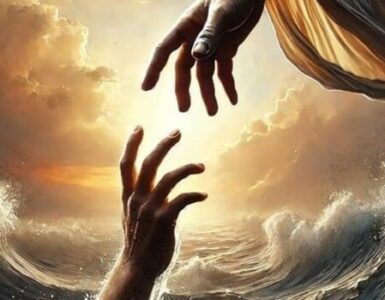“Why is this night different from all other nights?” is a question asked at the Pesach Haggadah, the Jewish Passover meal, by the youngest at the table capable of asking the question. Christians ask a similar question about Holy Week: “Why is this week different from all other weeks?”
It begins with Evening Prayer I on the Saturday before Palm (Passion) Sunday. A recollected intensity, peaceful yet urgent, settles into the minds and hearts of the Christian faithful who enter deeply into the Paschal Mystery during Holy Week. It begins just as any other week, but is a week unlike any other, the quiet precursor to the build-up of the powerful, symphonic explosiveness in the seamless transition from Holy Thursday into Good Friday. Then follows the melancholy denouement of the rapid, almost immediate descent into the silence and solemnity of Holy Saturday. Culminating in the awesome reverence up to the first moments of the Easter Vigil, it is, by far, the most transformative spiritual experience available to humanity.
But it was all meant to be. Scriptural signs aplenty point to the work Christ would accomplish to redeem humanity. And the pinnacle of his work in salvation history is Holy Week, a labor of love both mysterious and sacred.
The Sign of Isaiah
“Therefore the Lord himself shall give you a sign. Behold, a Virgin shall conceive and bear a son and his name shall be called Emmanuel” (Is 7:14)
Holy Week accompanies a sense of anticipatory heaviness in the air, almost indiscernible, yet definitively present. There is a yearning, perhaps, to experience more personally and fully the entirety of the story of the swaddled babe whose birth was predicted 700 years before by Isaiah and foretold by the angel.
God became a man for the express purpose of suffering before Pilate, abuse at the merciless hands of the Roman soldiers, stumbling along the ominous road to Calvary and gasping out his last excruciating hours on Golgotha. We see the signs foretold in the Suffering Servant passages in Isaiah:
“He was spurned and avoided by men, a man of suffering, knowing pain, Like one from whom you turn your face, spurned, and we held him in no esteem. Yet it was our pain that he bore, our sufferings he endured…But he was pierced for our sins, crushed for our iniquity. He bore the punishment that makes us whole, by his wounds we are healed” (Is 53: 3-5)
The Sign of the Angel in Luke
“And this will be a sign for you: you will find an infant wrapped in swaddling clothes and lying in a manger” (Lk 2:12)
Undeniably, from Eden’s Tree of the Knowledge of Good and Evil, to the trees that constructed the Ark of the Flood and the Ark of the Covenant, to the tree that produced the wood from which the manger in Bethlehem was constructed, to the tree from which was hewn the wood to construct the Cross as the Tree of Life; these signs stretch across the vast expanse of human history in the Old and New Testaments, telling the most remarkably true story.
And all these tangible, mysterious (wooden) signs point directly to the means by which the Son of God, who was also the adopted Son of a carpenter, would fulfill his mission during Holy Week.
The 7 Signs in the Gospel of John
Jesus turning water into wine at the wedding feast at Cana (Jn 2: 1-11), the curing of the son of the royal official (Jn 4: 46-54), the healing of the paralytic (Jn 5: 2-18), the multiplication of the loaves (Jn 6: 1-15 ), Jesus walking on water (Jn 6: 16-21) and the raising of Lazarus (Jn 11: 1-44) are the well-known “seven signs” in John’s gospel calling our attention to the power and authority of Jesus which manifest his transformative mastery over the natural world through water, healing, abundance and the suspension of the usual order.
In and through these signs, Jesus demonstrates symbolically, practically and miraculously, his sacred authorship over life and death. But St. John also goes on to say “Now Jesus did many other signs in the presence of His disciples that are not written in this book. But these are written that you may come to believe that Jesus is the Messiah, the Son of God, and that through this belief you may have life in his name” (Jn 20: 30-31).
The Sign of Jonah
“Just as Jonah was in the belly of the whale three days and three nights, so will the Son of Man be in the heart of the earth three days and three nights” (Mt 12:40).
If this language was too subtle for his followers to comprehend, Jesus made this reality even easier to understand for his disciples several times in plainly predicting his Passion, among them:
“Behold, we are going up to Jerusalem, and the Son of Man will be handed over to the chief priests and the Scribes, and they will condemn him to death and hand him over to the Gentiles who will mock him, spit upon him, scourge him, and put him to death, but after three days he will rise” (Mk 10: 33-34).
A Sign of Contradiction
During the Sacred Triduum when we pray “Hail the Cross, our only hope” (Ave Crux spes unica), the Sorrowful Mysteries of the Rosary, and the Stations of the Cross take on a deeper and more clearly real significance during this holy time of grace. There is a mysterious realization of the Word becoming flesh to redeem us by succumbing to obedience through unimaginable suffering. The Cross, that commonly, readily recognized sign of capital punishment and death for centuries in the ancient world, is transformed into the symbol of life.
Nature and time during this week undergo a cosmic recalibration of sorts. While the world goes on about its business, oblivious to the magnanimity and wonder of its own re-creation, Christians are more keenly aware of a looming transcendence as the earth itself strains, because “We know that all creation is groaning in labor pains even until now” (Rm 8:22).
The Cross is the sign, the vehicle, through which Holy Week transpires. Yet the signs have always been there, hiding in plain sight. Perhaps the ancient homily for Holy Saturday best describes the atmosphere surrounding those three days Christ spent in the heart of the earth after the Cross and before his glorious resurrection:
“What is happening? Today there is a great silence over the earth, a great silence, and stillness, a great silence because the King sleeps; the earth was in terror and was still, because God slept in the flesh and raised up those who were sleeping from the ages. God has died in the flesh, and the underworld has trembled.”
Christians tremble as well, because even though we are asked “Were you there when they crucified my Lord?” we understand that at every Mass we experience this sacrifice of Jesus Christ on the Cross. Holy Week is wrought amid the pangs of our own exhaustion, both emotional and spiritual, which lead us to commemorating the moment where death had what it thought to be the final victory, the hopes and dreams of those who followed Christ were temporarily plunged into a depressed, fearful darkness and all appeared to be absolutely lost. It had to be that way, the “Way of the Cross” (Via Crucis), because the Father willed it. The Son cooperated as the Way, the Truth and the Life. He asks us to “…take and eat…take and drink…” as “the way” (economia in Greek)to eternal life. But we must also take to heart the words of Christ: “Whoever wishes to come after me must deny himself, take up his Cross and follow me” (Mt 16:24).
The Cross is our way, too. Our only way. Holy Week is holy and Good Friday is good only because of the Cross.
Read the Signs of Holy Week
These signs preceding the Paschal Mystery were always present in sacred scripture, believed by some and rejected by others. Our back and forth movements between home and the Holy Thursday Mass of the Lord’s Supper, the Solemn Liturgical Action of the Passion and Death of the Lord, and the Holy Saturday Easter Vigil help us believers live and enter into the critical final hours of Christ the Savior’s earthly journey.
The spiritual transformation of the natural world during these seven days is revealed to those who willingly embrace the silence of Holy Week as did Christ his Cross. It takes effort, however, and comes about only through quieting the mind, meditating on the Passion, and prayerfully, lovingly considering the signs and wonders illuminating the mystery.
✠












